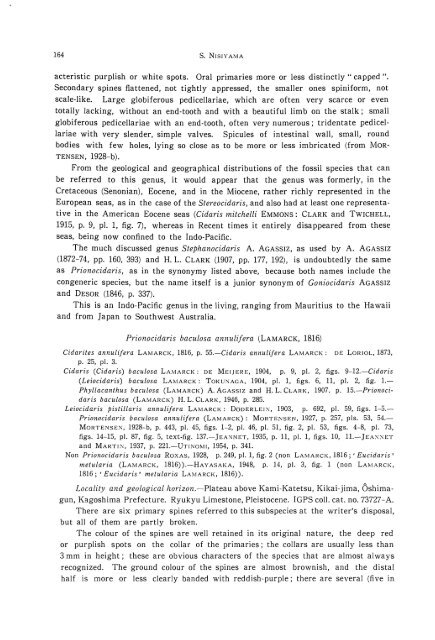the echinoid fauna from japan and adjacent regions part i
the echinoid fauna from japan and adjacent regions part i
the echinoid fauna from japan and adjacent regions part i
Create successful ePaper yourself
Turn your PDF publications into a flip-book with our unique Google optimized e-Paper software.
164 s. NISIY AyIA<br />
acteristic purplish or white spots. Oral primaries more or less distinctly" capped ".<br />
Secondary spines flattened, not tightly appressed, <strong>the</strong> smaller ones spiniform, not<br />
scale-like. Large globiferous pedicellariae, which are often very scarce or even<br />
totally lacking, without an end-tooth <strong>and</strong> with a beautiful limb on <strong>the</strong> stalk; small<br />
globiferous pedicellariae with an end-tooth, often very numerous; tridentate pedicellariae<br />
with very slender, simple valves. Spicules of intestinal wall, small, round<br />
bodies with few holes, lying so close as to be more or less imbricated (<strong>from</strong> MOR<br />
TENSEN, 1928-b).<br />
From <strong>the</strong> geological <strong>and</strong> geographical distributions of <strong>the</strong> fossil species that can<br />
be referred to this genus, it would appear that <strong>the</strong> genus was formerly, in <strong>the</strong><br />
Cretaceous (Senonian), Eocene, <strong>and</strong> in <strong>the</strong> Miocene, ra<strong>the</strong>r richly represented in <strong>the</strong><br />
European seas, as in <strong>the</strong> case of <strong>the</strong> Stereocidaris, <strong>and</strong> also had at least one representative<br />
in <strong>the</strong> American Eocene seas (Cidaris mitchelli EMMONS: CLARK <strong>and</strong> TWICHELL,<br />
1915, p. 9, pI. 1, fig. 7), whereas in Recent times it entirely disappeared <strong>from</strong> <strong>the</strong>se<br />
seas, being now confined to <strong>the</strong> Indo-Pacific.<br />
The much discussed genus Stephanocidaris A. AGASSIZ, as used by A. AGASSIZ<br />
(1872-74, pp. 160, 393) <strong>and</strong> H. L. CLARK (1907, pp. 177, 192), is undoubtedly <strong>the</strong> same<br />
as Prionocidaris, as in <strong>the</strong> synonymy listed above, because both names include <strong>the</strong><br />
congeneric species, but <strong>the</strong> name itself is a junior synonym of Goniocidaris AGASSIZ<br />
<strong>and</strong> DESOR (1846, p. 337).<br />
This is an Indo-Pacific genus in <strong>the</strong> living, ranging <strong>from</strong> Mauritius to <strong>the</strong> Hawaii<br />
<strong>and</strong> <strong>from</strong> Japan to Southwest Australia.<br />
Prionocidaris baculosa annulifera (LAMARCK, 1816)<br />
Cidarites annulifera LAMARCK, 1816, p. 55.-Cidaris annulifera LAMARCK: DE LORIOL, 1873,<br />
p. 25, pI. 3.<br />
Cidaris (Cidaris) baculosa LAMARCK: DE MEIJERE, 1904, p. 9, pI. 2, figs. 9-12.-Cidaris<br />
(Leiocidaris) baculosa LAMARCK: TOKU;-';AGA, 1904, pI. 1, figs. 6, 11, pI. 2, fig. 1.<br />
Phyllacanthus baculosa (LAMARCK) A. AGASSIZ <strong>and</strong> H. L. CLARK, 1907. p. 15.-Prionocidaris<br />
baculosa (LAMARCK) H. L. CLARK, 1946, p. 285.<br />
Leiocidaris pistillaris annulifera LAMARCK: DbDERLEI;-';, 1903, p. 692, pI. 59, figs. 1-5.<br />
Prionocidaris baculosa annulifera (LAMARCK): MORTENSEN, 1927, p. 257, pIs. 53, 54.<br />
MORTENSE;-';, 1928-b, p. 443, pI. 45, figs. 1-2, pI. 46, pI. 51, fig. 2, pI. 53, figs. 4-8, pI. 73,<br />
figs. 14-15, pI. 87, fig. 5, text-fig. 137.-JEA'INET, 1935, p. 11, pI. 1, figs. 10, 11.-JEA;-';"ET<br />
<strong>and</strong> MARTIi':, 1937, p. 221.-UTINOMI, 1954, p. 34l.<br />
Non Priollocidaris baculosa ROXAS, 1928, p. 249, pI. 1, fig. 2 (non LAMARCK, 1816; , Eucidaris'<br />
metularia (LAMARCK, 1816) ).-HAY ASAKA, 1948, p. 14, pI. 3, fig. 1 (non LAMARCK,<br />
1816; , Eucidaris' metularia LAyIARCK, 1816)).<br />
Locality <strong>and</strong> geological horizon.-Plateau above Kami-Katetsu, Kikai-jima, Oshimagun,<br />
Kagoshima Prefecture. Ryukyu Limestone, Pleistocene. IGPS colI. cat. no. 73727-A.<br />
There are six primary spines referred to this subspecies at <strong>the</strong> writer's disposal,<br />
but all of <strong>the</strong>m are <strong>part</strong>ly broken.<br />
The colour of <strong>the</strong> spines are well retained in its original nature, <strong>the</strong> deep red<br />
or purplish spots on <strong>the</strong> collar of <strong>the</strong> primaries; <strong>the</strong> collars are usually less than<br />
3 mm in height; <strong>the</strong>se are obvious characters of <strong>the</strong> species that are almost always<br />
recognized_ The ground colour of <strong>the</strong> spines are almost brownish, <strong>and</strong> <strong>the</strong> distal<br />
half is more or less clearly b<strong>and</strong>ed with reddish-purple; <strong>the</strong>re are several (five in












